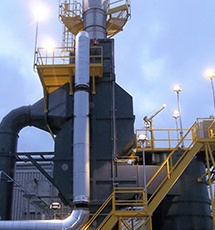A Regenerative Thermal Oxidizer (RTO) is an air pollution control device that is designed to destroy VOC, HAP, and odorous compounds in order to meet air pollution control regulations. RTOs can be used in small applications (4,000 scfm) to large ones (+100,000 scfm). There are many manufactures of RTOs with a wide variety of media, valves, and overall designs. While there are a lot of differences among the RTOs, one thing is true no matter which system you have installed in your plant: your RTO needs maintenance.




The most common maintenance areas for Regenerative Thermal Oxidizers are:
- RTO Media Failure and Maintenance
- RTO Burner Maintenance
- RTO Insulation Failure
- RTO Cold Face Support Failure
- RTO Poppet Switching Valve Failure
Manufacturing facilities are constantly under pressure to meet production forecasts at the lowest possible cost. Further complicating any Plant Manager’s responsibilities are EPA compliance requirements and working within the demands of EPA operating permits.
If an air pollution control device fails, most permits require the plant to shut down operations until the unit can be repaired. An air pollution control system failure then leaves the Plant Manager with a difficult choice: follow the requirements of the permit and shut down, thus losing valuable production time, or ignore the permit and risk paying a big penalty to the EPA. Any unplanned shut-down of an air pollution control device may be allowed under a variance to operate, depending on the permit in place. But to do so requires immediate notice to the appropriate EPA compliance department and an action plan to restore the system to permitted operating status.
It can be even worse to discover that an air pollution control system has not been performing properly. At most, a regulatory agency requires a facility to test for air pollution control device efficiency once per year. It is more common, however, for air pollution control devices to only be tested once every five years, or whenever the process responsible for controlling is modified. If a device fails to meet the control requirements listed in a permit, a monetary penalty demand is sure to follow. When calculating the amount of the penalty, the EPA will assume that the air pollution control system has been functioning improperly every day since the date of the last successfully completed stack test. A leaking heat exchanger, faulty valves, inaccurately calibrated thermocouples, and the degradation of catalyst are just some of causes that can result in a control device not meeting permit requirements.
In addition to avoiding penalties, keeping an air pollution control device running at optimum conditions is important to the bottom line. A properly tuned system reduces energy costs, both in terms of the amount of electricity used to operate blowers and valves and in terms of natural gas usage. Sometimes, optimizing the system is a simple matter of preventive maintenance. Sometimes, it’s a matter of keeping up with process changes. There is no reason, for example, to use the full capacity of a blower if changes upstream result in less air to control than the original design required. As is the case with every piece of production equipment, a thoughtful, intelligently designed maintenance plan more than pays for itself. Finally, most state regulations require facilities with air pollution control systems to have a maintenance program in place and to keep records of their program. The record keeping requirement is often overlooked and can be a way for an EPA inspector to assess a penalty for noncompliance, even if the air pollution control system is functioning properly and has in fact been maintained correctly.
conditions is important to the bottom line. A properly tuned system reduces energy costs, both in terms of the amount of electricity used to operate blowers and valves and in terms of natural gas usage. Sometimes, optimizing the system is a simple matter of preventive maintenance. Sometimes, it’s a matter of keeping up with process changes. There is no reason, for example, to use the full capacity of a blower if changes upstream result in less air to control than the original design required. As is the case with every piece of production equipment, a thoughtful, intelligently designed maintenance plan more than pays for itself. Finally, most state regulations require facilities with air pollution control systems to have a maintenance program in place and to keep records of their program. The record keeping requirement is often overlooked and can be a way for an EPA inspector to assess a penalty for noncompliance, even if the air pollution control system is functioning properly and has in fact been maintained correctly.
Our oxidizer service technicians have complied a list of tips we hope can help prevent costly repairs for your aging RTO. Download your copy today!









